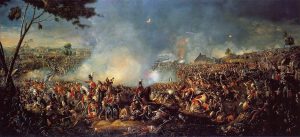
The Battle of Waterloo – the battle that changed the face of Europe – was fought in what is now Belgium on July 18th in 1815. It started to rain on the afternoon of 17 June and this continued into the night but the morning of the 18th was sunny and bright.
On the plateaus to the south of the village of Waterloo, near Mont St. Jean, the two armies were camped some 1500 yards apart, the French with 72000 men and the Anglo-Dutch with 68000 men. Although the ridge was not high there were hollows and ravines where forces could be hidden until an enemy drew close and troops could rise up completely unexpectedly. This was land which Wellington knew how to exploit.
Wellington located his reserves and some of his main force behind the slopes of the plateau he had chosen to make his stand on; they would be concealed from view and largely protected from artillery. To the west, forward of his right flank, he sent troops to Hougemont, which was a brick-and-stone redoubt, fully enclosed and further protected by ditches, an orchard and hedges. Directly to his front he sent another force to a similar mini-fortress, La Haye Sainte. No similar fortifications existed on his left, or eastern flank, though there were smaller strongholds scattered about. This was the direction from which he hoped the Prussians would be arriving to reinforce him so he was less concerned about it.
Bonaparte’s favourite tactic was envelopment, swinging around his enemy’s flanks, but the heavy rains had left the low ground muddy between the plateau where his forces waited and the plateau where the Anglo-Dutch had their line. The mud would slow his cavalry and artillery in any envelopment attempt. He chose, therefore, to make a direct attack on Wellington’s centre. The poor weather also caused him to delay his main attack from 9:00 a.m. to noon, to allow the ground more time to dry.

Bonaparte ordered General Reille to make an attack in the direction of Hougemont. It was intended to be a diversionary attack launched a half-hour before the main effort, but the commander of Reille’s lead division, after driving the enemy from some woods around the chateau, decided to attack the chateau itself. Both sides reinforced, and the fight drew in nearly half of Reille’s corps in a battle for a position of doubtful value to the French.
South of where the fighting was taking place, Grouchy had been ordered to seize Wavre and block the Prussians, but he moved slowly, and two corps had already passed through the town by the time his Frenchmen arrived. However, the same mud that had caused Napoleon to favor a direct assault over an enveloping maneuver also slowed the Prussian march to reinforce the Anglo-Dutch at Waterloo. Blucher pushed his men on, desperate to reinforce Wellington.
Knowing that the two forces would soon unite, Napoleon either had to withdraw to fight another day on better ground, or commit the rest of his force and hope to break Wellington’s line before Blücher’s full force arrived. Weighing against a retreat was the knowledge that an army of 250,000 Austrians were advancing toward Paris, and Napoleon was concerned that retreating would cost him support of the French people. He chose to decide the issue there and then.
For a half an hour he bombarded his enemy with 80 guns, but because Wellington had positioned much of his force on the downside of slopes away from the French artillery, the bombardment was not very effective.
Wellington reinforced La Haye Sainte and at around 4:00 p.m. both sides began heavy artillery bombardments. By now, Wellington’s centre began to disintegrate under the repeated French attacks and started to fall back. Marshal Ney, believing the Anglo-Dutch line was faltering, ordered a cavalry attack unsupported by infantry or artillery. The horsemen thundered forward, the ground shaking beneath the hooves of their mounts, crested a hill, and were greeted by British infantry formed in a patchwork of squares, the most effective defensive formation against cavalry. The French swept around the squares, trying to find a way to penetrate them, but momentum was broken. A counterattack by British cavalry drove the Frenchmen back, but reinforced, they came on again. Four times they charged, and four times they were repulsed.
By 6pm La Haye Sainte had fallen at last; Reille’s men had Hougomont surrounded, and a powerful attack against Wellington’s centre might have broken through, but the Prussians had begun arriving around 4pm and threatened the French rear by assaulting Plancenoit, a sizeable village with a stone church and stone-walled cemetery that could serve as strongpoints for either side. Napoleon directed a counterattack that gradually forced the Prussians back, but it took 10,000 French away from the central battle area, where they could have been used to break through Wellington’s weakened centre.
While Napoleon’s attention was focused on the Prussian threat to his rear, Ney took command of the rest of the Guard—some of the finest infantry in the world at the time—and led them in a futile attack against the strongest point of Wellington’s line. Finally, the French right flank caved, taking any remaining hope that Napoleon could avoid defeat. Napoleon ordered what was left of the Old Guard to form squares across the road south of La Haye Sainte while he withdrew his battered army.
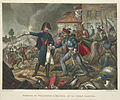
Wellington and Blucher met on the battlefield with little sense of triumph. The allies had lost about 23,000 men killed and wounded while the French had lost 25,000 with an additional 9,000 captured. Napoleon retreated to Paris, pursued first by the Prussians and then by the British, and on the 22 June abdicated for the second time. He had hoped to escape to America but realising that he could not evade the Royal Navy, surrendered to them and was sent into exile on St Helena.
Whatever the significance of the actual battle, Waterloo is a watershed in the history of Europe. After many years of war, the nations were to enjoy an extended period of peace which gave time for the development of trade and industry and the fast changes of the industrial revolution. Had Napoleon been able to see the Europe of 1860 he would have found it very different.
The Battle of Waterloo changes everything for the characters of my books. It was the Duke of Wellington’s last major battle although he remained in France for the next three years in command of the Army of Occupation. After that he returned to England and moved into the political arena and for Paul van Daan the close relationship with his commanding officer which had begun on a hillside in India slightly more than fifteen years earlier is going to change forever. Whatever his future relations with Wellington he will no longer be serving under his command.
For now, that day in 1815 is a long way off and the men of the 110th have a long war ahead of them. But since I know it is coming, the date of the Battle of Waterloo still feels like a landmark.

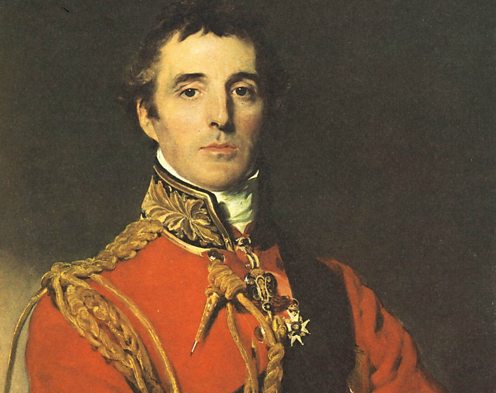
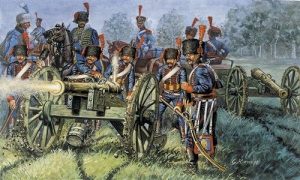 The Battle of Waterloo changed everything.
The Battle of Waterloo changed everything. 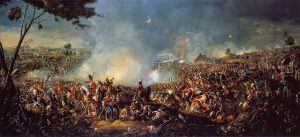 The Battle of Waterloo was fought on Sunday, 18 June 1815 in Belgium which was then part of the United Kingdom of the Netherlands. A French army under the command of Napoleon Bonaparte was defeated by two of the armies of the Seventh Coalition: an English-led Allied army under the command of the Duke of Wellington, and a Prussian army under the command of Gebhard Leberecht von Blücher, Prince of Wahlstatt.
The Battle of Waterloo was fought on Sunday, 18 June 1815 in Belgium which was then part of the United Kingdom of the Netherlands. A French army under the command of Napoleon Bonaparte was defeated by two of the armies of the Seventh Coalition: an English-led Allied army under the command of the Duke of Wellington, and a Prussian army under the command of Gebhard Leberecht von Blücher, Prince of Wahlstatt. Upon Napoleon’s return to power in March 1815, many states that had opposed him formed the Seventh Coalition, and began to mobilize armies. Wellington and Blücher’s armies were situated close to the north-eastern border of France and Bonaparte needed to attack and attack fast before the rest of the coalition could join them. The days of the Grande Army were long gone. Bonaparte had landed from Elba with a tiny force although he was picking up troops far more quickly than anybody had expected. Still many of his men were new recruits without the training and discipline of his armies of old, and he needed to buy time to bring them up to scratch. If he could defeat the English and Prussian armies he might be able to negotiate a temporary peace which would give him some time.
Upon Napoleon’s return to power in March 1815, many states that had opposed him formed the Seventh Coalition, and began to mobilize armies. Wellington and Blücher’s armies were situated close to the north-eastern border of France and Bonaparte needed to attack and attack fast before the rest of the coalition could join them. The days of the Grande Army were long gone. Bonaparte had landed from Elba with a tiny force although he was picking up troops far more quickly than anybody had expected. Still many of his men were new recruits without the training and discipline of his armies of old, and he needed to buy time to bring them up to scratch. If he could defeat the English and Prussian armies he might be able to negotiate a temporary peace which would give him some time. Upon learning that the Prussian army was able to support him,
Upon learning that the Prussian army was able to support him, 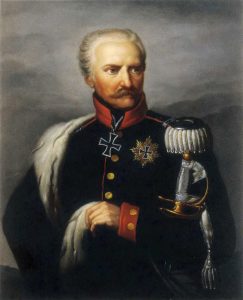 Crucially, the Prussians did not retreat to the east, along their own lines of communication. Instead, they, too, fell back northwards—parallel to Wellington’s line of march but still within communication with the English commander. The Prussians rallied on Bülow’s IV Corps, which had not been engaged at Ligny and was in a strong position south of Wavre and
Crucially, the Prussians did not retreat to the east, along their own lines of communication. Instead, they, too, fell back northwards—parallel to Wellington’s line of march but still within communication with the English commander. The Prussians rallied on Bülow’s IV Corps, which had not been engaged at Ligny and was in a strong position south of Wavre and  For the men of the 110th light infantry and the women who loved them it probably would have seemed like a nightmare. For a historical novelist in search of a dramatic plot line, it’s a bit of a gift.
For the men of the 110th light infantry and the women who loved them it probably would have seemed like a nightmare. For a historical novelist in search of a dramatic plot line, it’s a bit of a gift.